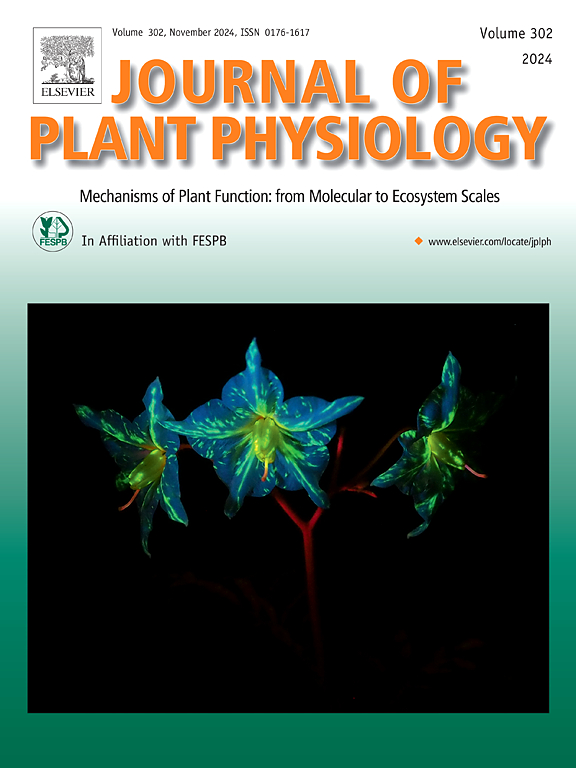Halophilic Bacillus improve barley growth on calcareous soil via enhanced photosynthetic performance and metabolomic re-programing
IF 4.1
3区 生物学
Q1 PLANT SCIENCES
引用次数: 0
Abstract
Plant Growth Promoting Rhizobacteria are a sustainable biological alternative to agrochemicals to improve plant growth and stress tolerance. In this work we used two Bacillus strains native to the saline rhizosphere of halophytic plants in order to improve the growth of barley on a calcareous soil (CS). This soil negatively affected plant development; however, the inoculation of barley with the halophytic Bacillus strains enhanced barley growth and photosynthesis performance. In fact, a significant increase of the maximum photochemical yield of PSII and PSI was observed following inoculation, leading to improved protection of these photosystems against photoinhibition. Moreover, a pairwise metabolomic pathway analysis in barley leaves and roots was performed. Compared to barley grown on non-calcareous soil (NCS), CS led to a downregulation of sugar-related metabolic pathways, which can be correlated with lower photosynthesis performance. Furthermore, the abundance of metabolites related to amino acids in leaves and phenylpropanoids and lipids in roots was also reduced by CS. This negative effect was reverted by the inoculation of the bacteria strains. In conclusion, halophilic Bacillus native to the saline rhizosphere of halophyte plants induced metabolic changes leading to an enhanced photosynthesis activity, and hence, alleviating the deleterious effect of CS on barley development.
嗜盐芽孢杆菌通过提高光合性能和代谢组重编程来改善钙质土壤上大麦的生长
促进植物生长的根杆菌是一种可持续的生物农药替代品,可以提高植物的生长和抗逆性。为了提高大麦在钙质土壤(CS)上的生长,本研究使用了盐生植物盐根圈原生的两株芽孢杆菌。这种土壤对植物发育有负面影响;然而,用盐生芽孢杆菌菌株接种大麦可提高大麦的生长和光合性能。事实上,接种后PSII和PSI的最大光化学产量显著增加,从而提高了这些光系统对光抑制的保护。此外,还进行了大麦叶片和根的成对代谢组学途径分析。与生长在非钙质土壤(NCS)上的大麦相比,CS导致糖相关代谢途径的下调,这可能与光合性能降低有关。此外,CS还降低了叶片中氨基酸相关代谢物和根中苯丙素和脂类物质的丰度。这种负面影响通过接种菌株而得到逆转。综上所述,盐生植物盐根圈原生嗜盐芽孢杆菌诱导代谢变化,提高光合活性,从而减轻CS对大麦发育的有害影响。
本文章由计算机程序翻译,如有差异,请以英文原文为准。
求助全文
约1分钟内获得全文
求助全文
来源期刊

Journal of plant physiology
生物-植物科学
CiteScore
7.20
自引率
4.70%
发文量
196
审稿时长
32 days
期刊介绍:
The Journal of Plant Physiology is a broad-spectrum journal that welcomes high-quality submissions in all major areas of plant physiology, including plant biochemistry, functional biotechnology, computational and synthetic plant biology, growth and development, photosynthesis and respiration, transport and translocation, plant-microbe interactions, biotic and abiotic stress. Studies are welcome at all levels of integration ranging from molecules and cells to organisms and their environments and are expected to use state-of-the-art methodologies. Pure gene expression studies are not within the focus of our journal. To be considered for publication, papers must significantly contribute to the mechanistic understanding of physiological processes, and not be merely descriptive, or confirmatory of previous results. We encourage the submission of papers that explore the physiology of non-model as well as accepted model species and those that bridge basic and applied research. For instance, studies on agricultural plants that show new physiological mechanisms to improve agricultural efficiency are welcome. Studies performed under uncontrolled situations (e.g. field conditions) not providing mechanistic insight will not be considered for publication.
The Journal of Plant Physiology publishes several types of articles: Original Research Articles, Reviews, Perspectives Articles, and Short Communications. Reviews and Perspectives will be solicited by the Editors; unsolicited reviews are also welcome but only from authors with a strong track record in the field of the review. Original research papers comprise the majority of published contributions.
 求助内容:
求助内容: 应助结果提醒方式:
应助结果提醒方式:


